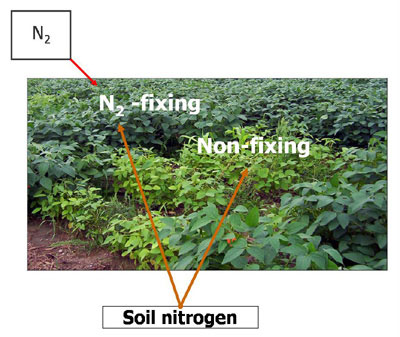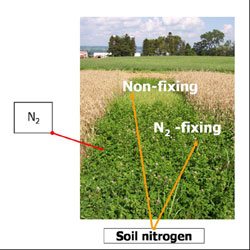Researching legume nitrogen fixation module
Measuring legume N fixation
Measuring legume N fixation
Several different methods have been used over the years to measure legume N fixation and they all have certain limitations. The 15N natural abundance method was used for these studies. This method relies on the fact that the N in the atmosphere has a different fingerprint than the N in the soil. This fingerprint is based on the relative abundance of the two naturally-occurring N isotopes, 15N and 14N. The fingerprint of the air is very constant. By comparing the N in a non-fixing plant that has the N fingerprint of the soil to the N in a legume, we can calculate what percentage of the N in the legume came from the soil and what percentage came from the air.

Figure 1. For soybeans, a mutant variety that does not develop nodules was used as the non-fixing plant. Nitrogen fixation is measured by comparing the composition of the N in the non-fixing plant to the N in the fixing plants.

Larger image, |
Figure 3. A) Total soil nitrogen increased and, B) soybean nitrogen fixed decreased with time under organic management. Total soil N is highly correlated with total soil organic matter. |
Oats were used as the non-fixing plants to measure N fixation in the field peas. Grasses are not an ideal non-fixing plant to use because they have different growth and rooting patterns than the legumes. Non-nodulating mutants do not exist for most legumes as they do for soybean.
Back to:
© Copyright, Department of Horticulture, Cornell University.
Logo graphics by Rachel Kennedy.
Design by Craig Cramer.
Mention of trade names and commercial products is for educational purposes; no discrimination is intended and no endorsement by Cornell Cooperative Extension or Cornell University is implied. Pesticide recommendations are for informational purposes only and manufacturers' recommendations change. Read the manufacturers' instructions carefully before use. Cornell Cooperative Extension and Cornell University assumes no responsibility for the use of any pesticide or chemicals. Some of the links provided are not maintained by Cornell Cooperative Extension and Cornell University. Cornell Cooperative Extension and Cornell University are not responsible for information on these websites. They are included for information purposes only and no endorsement by Cornell Cooperative Extension or Cornell University is implied. Cornell Cooperative Extension provides equal program and employment opportunities.